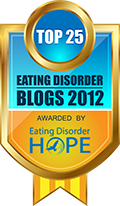Models, Fashion, and Eating Disorders
 Image courtesy of Indexed
Image courtesy of Indexed
Part I: A Zero-Sum Problem
I've shied away from speaking directly about models and the whole "size-zero" phenomenon. Partly because I think it gets away from the ultimate cause of eating disorders: genetics, biology, neurochemistry. Eating disorders date back hundreds of years- long before fashion models. Even in the 1600s, where the ideal body type was far more realistic to what Nature had intended, people had anorexia. Women. And men.
This happened without fashion models, without a diet culture.
And yet.
Yet at the same time, disordered eating is essentially more prevalant than a relaxed attitude around food and body weight. It's The Media, we say. Hollywood. The Fashion Industry. The Patriarchy. All of these are true, in a sense. It certainly normalizes these food and body obsessions of ours. It allows eating disorders to fester and hide.
And, given that dieting is the "gateway drug" to eating disorders, this obsession can trigger (but not cause) EDs.
A lot of the impetus on banning Size Zero models is that it will prevent eating disorders. Or help to prevent them. Which is all well and good, and I certainly don't think it will hurt, but I'm not sure this will do a whole lot to prevent eating disorders on a large scale. It will send a message, and that's the important part. It is a start to ending this body obsession of ours.
Part II: A model of what?
Maybe what we need to be asking ourselves first is: what is a model, anyway? Are they supposed to be models of "good behavior"? Of what clothes to wear and how to look in them? Of what a young child should aspire to one day? Of something else entirely?
It's no secret that eating disorders are rampant in the fashion industry. Most of those body weights are unnatural. I won't go as far to say "all" models are starving, because I really just don't know. But the weights are unrealistic for basically all young men and women out there.
Study after study (the most famous of which was the Minnesota Starvation Study by Ancel Keys) has shown that restricting your diet and forcing your weight below its natural setpoint makes you, in less scientific terms, utterly batshit crazy. Your hair falls out. Your nails stop growing. Your skin gets scaly. You have so many bruises it looks like someone hammered you with a baseball bat.* Your period stops. You can't think of anything but food.
This isn't healthy.
The personal antics and behaviors of those in the fashion industry aside (Kate Moss, anyone?), the ideal woman in this society is fundamentally unhealthy. This is a model? Something that's held up as the highest form of beauty and flattery and achievement?
And if models are supposed to be displaying how clothes are "supposed" to look on people, why are they using people who don't look like almost anyone else in the population? I'm not willowy and 5 foot 9; I'm about 5 foot 5 and muscular and athletic.
On the other hand, what about the models?
Part III: The Fashion Police
Here is the one, over-arching reason I think there should be a regulation of models' body weights: for their own health and safety.
I've read comments on newspaper articles about this issue (most recently in Fashion Week in Madrid), who say that this type of regulation is overly paternalistic. Intrusive.
Yet I had an N-95 mask given to me when I worked at the health department to prevent me from breathing in germs during an outbreak. The lawnmower guy my dad hired last summer had ear plugs. Welders use goggles. These are required by law.
Why? Most companies aren't willing to shell out the money to protect their workers. So the government had to step in and make sure that companies were doing what they were supposed to be doing.
It's the same thing here. We think of models as these independent entities, figures strutting on catwalks, images on magazines. Most of them are employees- of a modeling agency, of a clothing company. If eating disorders are an inherent danger in the industry (as infectious disease is in public health), then there need to be measures to protect the workers.
The public is apt to blame the models. "Stupid girls, being such an unhealthy model for my little girl." Or, "They should just stop."
And that last reason adds fuel to the need for these regulations. People with eating disorders, people whose cognitive abilities are comprimised by starvation, don't realize they're sick. It's called anogosnia- a lack of insight into disease, which is common in many neurological disorders, such as brain injury and stroke. Semantics aside, eating disorders, strokes, and Alzheimers are all brain diseases. Pancreatic cancer and diabetes are diseases of the pancreas. Totally different cause and etiology, yet they are not treated as two totally different entities with totally different insurance coverage.**
Are models victims? Well I don't know.
Are they in need of protection? You better believe it.
*It took me about 8 doctors to figure out that I wasn't bruised up because of medication or klutziness (though I'm sure that didn't help). I took Vitamin C supplements, which helped somewhat. Then my psychiatrist took one look at my battered legs and told me I had a Vitamin K deficiency. Vitamin K is a fat-soluble vitamin and is crucial to helping blood clot. So my fat intake was upped and within a week, the bruises were essentially gone.
**Don't. Start. Me. On. This.






No comments:
Post a Comment